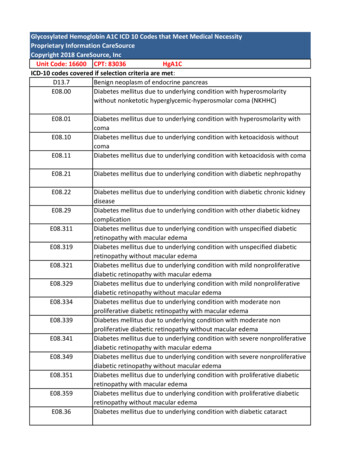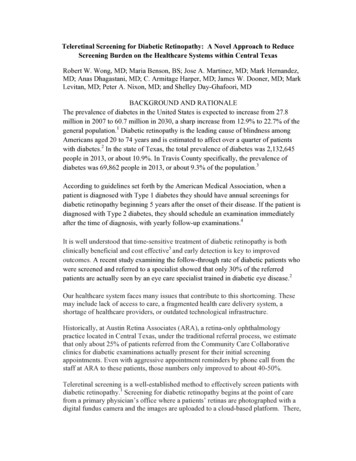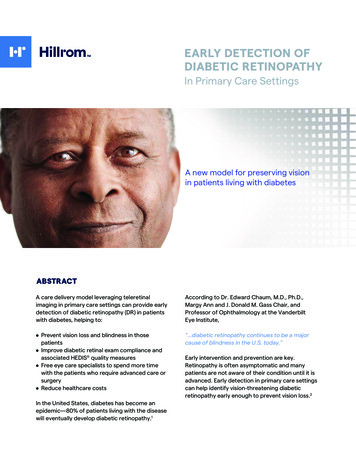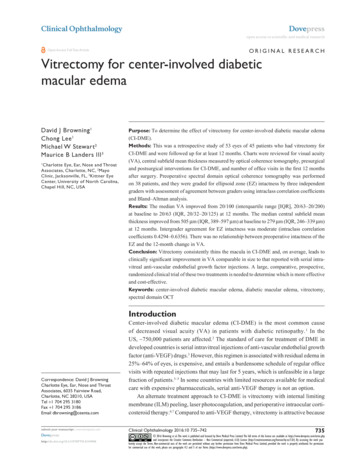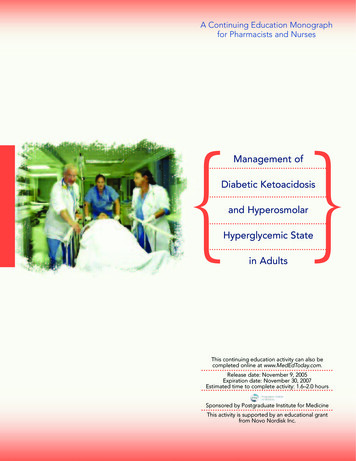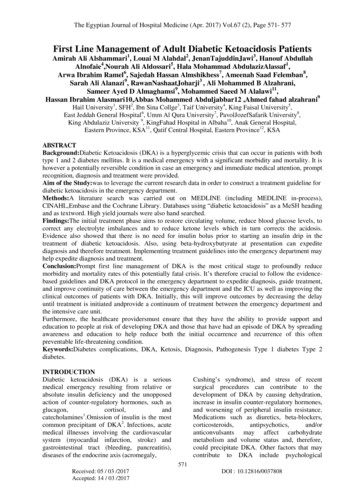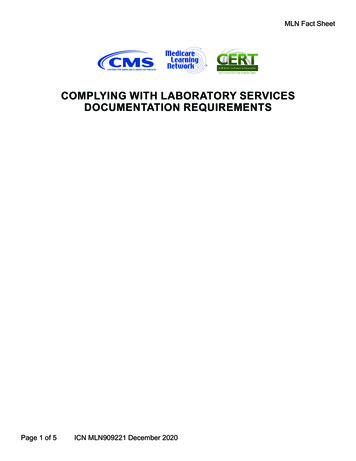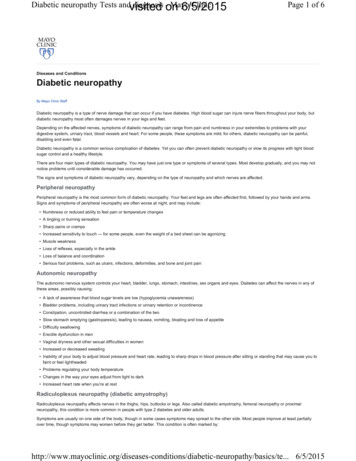
Transcription
Diabetic neuropathy Tests andvisiteddiagnosis on- MayoClinic6/5/2015Page 1 of 6Diseases and ConditionsDiabetic neuropathyBy Mayo Clinic StaffDiabetic neuropathy is a type of nerve damage that can occur if you have diabetes. High blood sugar can injure nerve fibers throughout your body, butdiabetic neuropathy most often damages nerves in your legs and feet.Depending on the affected nerves, symptoms of diabetic neuropathy can range from pain and numbness in your extremities to problems with yourdigestive system, urinary tract, blood vessels and heart. For some people, these symptoms are mild; for others, diabetic neuropathy can be painful,disabling and even fatal.Diabetic neuropathy is a common serious complication of diabetes. Yet you can often prevent diabetic neuropathy or slow its progress with tight bloodsugar control and a healthy lifestyle.There are four main types of diabetic neuropathy. You may have just one type or symptoms of several types. Most develop gradually, and you may notnotice problems until considerable damage has occurred.The signs and symptoms of diabetic neuropathy vary, depending on the type of neuropathy and which nerves are affected.Peripheral neuropathyPeripheral neuropathy is the most common form of diabetic neuropathy. Your feet and legs are often affected first, followed by your hands and arms.Signs and symptoms of peripheral neuropathy are often worse at night, and may include: Numbness or reduced ability to feel pain or temperature changes A tingling or burning sensation Sharp pains or cramps Increased sensitivity to touch — for some people, even the weight of a bed sheet can be agonizing Muscle weakness Loss of reflexes, especially in the ankle Loss of balance and coordination Serious foot problems, such as ulcers, infections, deformities, and bone and joint painAutonomic neuropathyThe autonomic nervous system controls your heart, bladder, lungs, stomach, intestines, sex organs and eyes. Diabetes can affect the nerves in any ofthese areas, possibly causing: A lack of awareness that blood sugar levels are low (hypoglycemia unawareness) Bladder problems, including urinary tract infections or urinary retention or incontinence Constipation, uncontrolled diarrhea or a combination of the two Slow stomach emptying (gastroparesis), leading to nausea, vomiting, bloating and loss of appetite Difficulty swallowing Erectile dysfunction in men Vaginal dryness and other sexual difficulties in women Increased or decreased sweating Inability of your body to adjust blood pressure and heart rate, leading to sharp drops in blood pressure after sitting or standing that may cause you tofaint or feel lightheaded Problems regulating your body temperature Changes in the way your eyes adjust from light to dark Increased heart rate when you're at restRadiculoplexus neuropathy (diabetic amyotrophy)Radiculoplexus neuropathy affects nerves in the thighs, hips, buttocks or legs. Also called diabetic amyotrophy, femoral neuropathy or proximalneuropathy, this condition is more common in people with type 2 diabetes and older adults.Symptoms are usually on one side of the body, though in some cases symptoms may spread to the other side. Most people improve at least partiallyover time, though symptoms may worsen before they get better. This condition is often marked iabetic-neuropathy/basics/te. 6/5/2015
Diabetic neuropathy Tests andvisiteddiagnosis on- MayoClinic6/5/2015Page 2 of 6 Sudden, severe pain in your hip and thigh or buttock Eventual weak and atrophied thigh muscles Difficulty rising from a sitting position Abdominal swelling, if the abdomen is affected Weight lossMononeuropathyMononeuropathy involves damage to a specific nerve. The nerve may be in the face, torso or leg. Mononeuropathy, also called focal neuropathy, oftencomes on suddenly. It's most common in older adults.Although mononeuropathy can cause severe pain, it usually doesn't cause any long-term problems. Symptoms usually diminish and disappear on theirown over a few weeks or months. Signs and symptoms depend on which nerve is involved and may include: Difficulty focusing your eyes, double vision or aching behind one eye Paralysis on one side of your face (Bell's palsy) Pain in your shin or foot Pain in your lower back or pelvis Pain in the front of your thigh Pain in your chest or abdomenSometimes mononeuropathy occurs when a nerve is compressed. Carpal tunnel syndrome is a common type of compression neuropathy in people withdiabetes.Signs and symptoms of carpal tunnel syndrome include: Numbness or tingling in your fingers or hand, especially in your thumb, index finger, middle finger and ring finger A sense of weakness in your hand and a tendency to drop thingsWhen to see a doctorSeek medical care if you notice: A cut or sore on your foot that doesn't seem to be healing, is infected or is getting worse Burning, tingling, weakness or pain in your hands or feet that interferes with your daily routine or your sleep Dizziness Changes in your digestion, urination or sexual functionThese signs and symptoms don't always indicate nerve damage, but they may signal other problems that require medical care. Early diagnosis andtreatment offer the best chance for controlling symptoms and preventing more-severe problems.Even minor sores on the feet that don't heal can turn into ulcers. In the most severe cases, untreated foot ulcers may become gangrenous — a conditionin which the tissue dies — and require surgery or even amputation of your foot. Early treatment can help prevent this from happening.Damage to nerves and blood vesselsProlonged exposure to high blood sugar can damage delicate nerve fibers, causing diabetic neuropathy. Why this happens isn't completely clear, but acombination of factors likely plays a role, including the complex interaction between nerves and blood vessels.High blood sugar interferes with the ability of the nerves to transmit signals. It also weakens the walls of the small blood vessels (capillaries) that supplythe nerves with oxygen and nutrients.Other factorsOther factors that may contribute to diabetic neuropathy include: Inflammation in the nerves caused by an autoimmune response. This occurs when your immune system mistakenly attacks part of your body as ifit were a foreign organism. Genetic factors unrelated to diabetes that make some people more susceptible to nerve damage. Smoking and alcohol abuse, which damage both nerves and blood vessels and significantly increase the risk of infections.Anyone who has diabetes can develop neuropathy, but these factors make you more susceptible to nerve damage: Poor blood sugar control. This is the greatest risk factor for every complication of diabetes, including nerve damage. Keeping blood sugarconsistently within your target range is the best way to protect the health of your nerves and blood vessels. Length of time you have diabetes. Your risk of diabetic neuropathy increases the longer you have diabetes, especially if your blood sugar isn't wellcontrolled. Kidney disease. Diabetes can cause damage to the kidneys, which may increase the toxins in the blood and contribute to nerve damage. Being overweight. Having a body mass index greater than 24 may increase your risk of developing diabetic neuropathy. Smoking. Smoking narrows and hardens your arteries, reducing blood flow to your legs and feet. This makes it more difficult for wounds to heal anddamages the integrity of the peripheral ns/diabetic-neuropathy/basics/te. 6/5/2015
Diabetic neuropathy Tests andvisiteddiagnosis on- MayoClinic6/5/2015Page 3 of 6Diabetic neuropathy can cause a number of serious complications, including: Loss of a limb. Because nerve damage can cause a lack of feeling in your feet, cuts and sores may go unnoticed and eventually become severelyinfected or ulcerated — a condition in which the skin and soft tissues break down. The risk of infection is high because diabetes reduces blood flow toyour feet. Infections that spread to the bone and cause tissue death (gangrene) may be impossible to treat and require amputation of a toe, foot oreven the lower leg. Charcot joint. This occurs when a joint, usually in the foot, deteriorates because of nerve damage. Charcot joint is marked by loss of sensation, aswell as swelling, instability and sometimes deformity in the joint itself. Early treatment can promote healing and prevent further damage. Urinary tract infections and urinary incontinence. Damage to the nerves that control your bladder can prevent it from emptying completely. Thisallows bacteria to multiply in your bladder and kidneys, leading to urinary tract infections. Nerve damage can also affect your ability to feel when youneed to urinate or to control the muscles that release urine. Hypoglycemia unawareness. Normally, when your blood sugar drops too low — below 70 milligrams per deciliter (mg/dL), or 3.9 millimoles per liter(mmol/L) — you develop symptoms such as shakiness, sweating and a fast heartbeat. Autonomic neuropathy can interfere with your ability to noticethese symptoms. Low blood pressure. Damage to the nerves that control circulation can affect your body's ability to adjust blood pressure. This can cause a sharpdrop in pressure when you stand after sitting (orthostatic hypotension), which may lead to dizziness and fainting. Digestive problems. Nerve damage in the digestive system can cause constipation or diarrhea — or alternating bouts of constipation and diarrhea— as well as nausea, vomiting, bloating and loss of appetite. It can also cause gastroparesis, a condition in which the stomach empties too slowly ornot at all. This can interfere with digestion and cause nausea, vomiting and bloating, and severely affect blood sugar levels and nutrition. Sexual dysfunction. Autonomic neuropathy often damages the nerves that affect the sex organs, leading to erectile dysfunction in men andproblems with lubrication and arousal in women. Increased or decreased sweating. When the sweat glands don't function normally, your body isn't able to regulate its temperature properly. Areduced or complete lack of perspiration (anhidrosis) can be life-threatening. Autonomic neuropathy may also cause excessive sweating, particularlyat night or while eating.If you don't already see an endocrinologist, you'll likely be referred to one if you start showing signs of diabetes complications. An endocrinologist is adoctor who specializes in treating metabolic disorders, such as diabetes. You may also be referred to a doctor who specializes in treating nervoussystem problems (neurologist).To prepare for your appointment, you may want to: Be aware of any pre-appointment restrictions. When you make the appointment, ask if there's anything you need to do in advance, such as restrictyour diet. Write down any symptoms you're experiencing, including any that may seem unrelated to the reason for which you scheduled the appointment. Write down key personal information, including any major stresses or recent life changes. Make a list of all medications, vitamins and supplements you're taking. Write down your recent blood sugar levels, if you check them at home. Ask a family member or friend to come with you. It can be difficult to remember everything your doctor tells you during an appointment. Someonewho accompanies you may remember something that you missed or forgot. Write down questions to ask your doctor.Preparing a list of questions can help you make the most of your time with your doctor. For diabetic neuropathy, some basic questions include: Is diabetes the most likely cause of my symptoms? Do I need tests to confirm the cause of my symptoms? Do these tests require any special preparation? Is this condition temporary or long lasting? If I control my blood sugar, will these symptoms improve or go away? Are there treatments available, and which do you recommend? What types of side effects can I expect from treatment? I have other health conditions. How can I best manage them together? Are there brochures or other printed material I can take with me? What websites do you recommend? Do I need to see other doctors, a certified diabetes educator or a dietitian?What to expect from your doctorYour doctor is likely to ask you a number of questions, such as: How is your blood sugar control? When did you begin experiencing symptoms? Have your symptoms been continuous or occasional? How severe are your symptoms? Does anything seem to improve your symptoms? What, if anything, appears to worsen your symptoms? What aspects of diabetes management do you find most challenging? What might help you manage your diabetes ns/diabetic-neuropathy/basics/te. 6/5/2015
Diabetic neuropathy Tests andvisiteddiagnosis on- MayoClinic6/5/2015Page 4 of 6Diabetic neuropathy is usually diagnosed based on your symptoms, your medical history and a physical exam. During the exam, your doctor is likely tocheck your muscle strength and tone, tendon reflexes, and sensitivity to touch, temperature and vibration.Your doctor may also conduct tests that include: Filament test. Sensitivity to touch may be tested using a soft nylon fiber called a monofilament. Nerve conduction studies. This test measures how quickly the nerves in your arms and legs conduct electrical signals. It's often used to diagnosecarpal tunnel syndrome. Electromyography (EMG). Often performed along with nerve conduction studies, electromyography measures the electrical discharges produced inyour muscles. Quantitative sensory testing. This noninvasive test is used to assess how your nerves respond to vibration and changes in temperature. Autonomic testing. If you have symptoms of autonomic neuropathy, your doctor may request special tests to look at your blood pressure in differentpositions and assess your ability to sweat.The American Diabetes Association recommends that all people with diabetes have a comprehensive foot exam — either by a doctor or by a footspecialist (podiatrist) — at least once a year. In addition, your feet should be checked for sores, cracked skin, calluses, blisters, and bone and jointabnormalities at every office visit.Diabetic neuropathy has no known cure. Treatment for diabetic neuropathy focuses on: Slowing progression of the disease Relieving pain Managing complications and restoring functionSlowing progression of the diseaseConsistently keeping blood sugar within a target range can help prevent or delay the progression of diabetic neuropathy and may even improve some ofthe symptoms you already have. Your doctor will determine the best target range for you based on several factors, such as your age, how long you'vehad diabetes, and your overall health and the presence of other medical conditions.For many people who have diabetes, Mayo Clinic generally recommends target blood sugar levels that are: Between 80 and 120 mg/dL, or 4.4 and 6.7 mmol/L, for people age 59 and younger who have no other underlying medical conditions Between 100 and 140 mg/dL, or 5.6 and 7.8 mmol/L, for people age 60 and older, or those who have other medical conditions, such as heart, lung orkidney diseaseTo help slow nerve damage: Follow your doctor's recommendations for good foot care Keep your blood pressure under control Follow a healthy-eating plan Get plenty of physical activity Maintain a healthy weight Stop smoking Avoid alcohol or, if drinking is allowed, drink only in moderationRelieving painSeveral medications are used to relieve nerve pain, but they don't work for everyone and most have side effects that must be weighed against thebenefits they offer. There are also a number of alternative therapies, such as capsaicin cream (made from chili peppers), physical therapy oracupuncture, that may help with pain relief. Doctors frequently use them in conjunction with medications, but some may be effective on their own.Pain-relieving treatments may include: Anti-seizure medications. Although drugs such as gabapentin (Gralise, Neurontin), pregabalin (Lyrica) and carbamazepine (Carbatrol, Tegretol) areused to treat seizure disorders (epilepsy), they're also prescribed for nerve pain. Side effects may include drowsiness, dizziness and swelling. Antidepressants. Tricyclic antidepressant medications, such as amitriptyline, desipramine (Norpramin) and imipramine (Tofranil), may provide relieffor mild to moderate symptoms by interfering with chemical processes in your brain that cause you to feel pain, but they also cause a number of sideeffects, such as dry mouth, sweating, weight gain, constipation and dizziness.For some people, antidepressants called serotonin and norepinephrine reuptake inhibitors (SNRIs), such as duloxetine (Cymbalta), can relieve painwith fewer side effects. Possible side effects of SNRIs include nausea, sleepiness, dizziness, decreased appetite and constipation.Managing complications and restoring functionSpecific treatments exist for many of the complications of neuropathy, including: Urinary tract problems. Antispasmodic medications (anticholinergics), behavioral techniques such as timed urination, and devices such aspessaries — rings inserted into the vagina to prevent urine leakage — may be helpful in treating loss of bladder control. A combination of therapiesmay be most tions/diabetic-neuropathy/basics/te. 6/5/2015
Diabetic neuropathy Tests andvisiteddiagnosis on- MayoClinic6/5/2015Page 5 of 6 Digestive problems. To relieve mild signs and symptoms of gastroparesis — indigestion, belching, nausea or vomiting — doctors suggest eatingsmaller, more-frequent meals, reducing fiber and fat in the diet, and, for many people, eating soups and pureed foods. Dietary changes andmedications may help relieve diarrhea, constipation and nausea. Low blood pressure on standing (orthostatic hypotension). This is often helped with simple lifestyle measures, such as avoiding alcohol,drinking plenty of water, and sitting or standing slowly. Your doctor may recommend an abdominal binder, a compression support for your abdomen,and compression stockings. Several medications, either alone or together, may be used to treat orthostatic hypotension. Sexual dysfunction. Sildenafil (Revatio, Viagra), tadalafil (Adcirca, Cialis) and vardenafil (Levitra) may improve sexual function in some men, butthese medications aren't effective or safe for everyone. Mechanical vacuum devices may increase blood flow to the penis. Women may find reliefwith vaginal lubricants.These measures can help reduce your risk of diabetic neuropathy: Keep your blood pressure under control. People with diabetes are more likely to have high blood pressure than are people who don't havediabetes. Having both high blood pressure and diabetes greatly increases your risk of complications because both damage your blood vessels andreduce blood flow. Try to keep your blood pressure in the range your doctor recommends, and be sure to have it checked at every office visit. Make healthy food choices. Eat a balanced diet that includes a variety of healthy foods — especially fruits, vegetables and whole grains — andlimit portion sizes to help achieve or maintain a healthy weight. Be active every day. Daily activity protects your heart and improves blood flow. It also plays a major role in keeping your blood sugar and bloodpressure under control. The American Diabetes Association generally recommends about 30 minutes of moderate exercise a day at least five times aweek.If you have severe neuropathy and decreased sensation in your legs, your doctor may recommend that you participate in non-weight-bearingactivities, such as bicycling or swimming. Stop smoking. If you have diabetes and use tobacco in any form, you're more likely than are nonsmokers with diabetes to die of heart attack orstroke. And you're more likely to develop circulation problems in your feet. If you use tobacco, talk to your doctor about finding ways to quit.There are a number of alternative treatments that may help relieve the pain of diabetic neuropathy, such as: Capsaicin. When applied to the skin, capsaicin cream can reduce pain sensations in some people. Side effects may include a burning feeling andskin irritation. Alpha-lipoic acid. This powerful antioxidant is found in some foods and may help relieve the symptoms of peripheral neuropathy. Transcutaneous electrical nerve stimulation (TENS). Your doctor may prescribe this therapy, which can help prevent pain signals from reachingyour brain. TENS delivers tiny electrical impulses to specific nerve pathways through small electrodes placed on your skin. Although safe andpainless, TENS doesn't work for everyone or for all types of pain. Acupuncture. Acupuncture may help relieve the pain of neuropathy, and generally doesn't have any side effects. Keep in mind that you may not getimmediate relief with acupuncture and will likely require more than one session.Living with diabetic neuropathy can be difficult and frustrating. If you find yourself getting down, it may help to talk to a counselor or therapist.Members of support groups can also offer you encouragement, as well as advice about living with diabetic neuropathy. Ask your doctor about supportgroups in your area, or for a referral to a therapist. The American Diabetes Association offers online support through its website.You can help prevent or delay diabetic neuropathy and its complications by keeping your blood sugar consistently well-controlled, taking good care ofyour feet and following a healthy lifestyle.Blood sugar controlKeeping your blood sugar tightly controlled requires continuous monitoring and, if you take insulin, frequent doses of medication. But keeping your bloodsugar consistently within your target range is the best way to help prevent neuropathy and other complications of diabetes. Consistency is importantbecause shifts in blood sugar levels can accelerate nerve damage.The American Diabetes Association recommends that people with diabetes have a blood test called the A1C test at least twice a year to find out youraverage blood sugar level for the past two to three months. If your blood sugar isn't well-controlled or you change medications, you may need to gettested more often.Foot careFoot problems, including sores that don't heal, ulcers and even amputation, are a common complication of diabetic neuropathy. But you can preventmany of these problems by having a comprehensive foot exam at least once a year, having your doctor check your feet at each office visit and takinggood care of your feet at home.To protect the health of your feet: Check your feet every day. Look for blisters, cuts, bruises, cracked and peeling skin, redness and swelling. Use a mirror or ask a friend or familymember to help examine parts of your feet that are hard to see. Keep your feet clean and dry. Wash your feet every day with lukewarm water and mild soap. Avoid soaking your feet. Dry your feet and betweenyour toes carefully by blotting or patting with a soft towel.Moisturize your feet thoroughly to prevent cracking. Avoid getting lotion between your toes, however, as this can encourage fungal growth. Trim your toenails carefully. Cut your toenails straight across, and file the edges carefully so there are no sharp edges. Wear clean, dry socks. Look for socks made of cotton or moisture-wicking fibers that don't have tight bands or thick s/diabetic-neuropathy/basics/te. 6/5/2015
Diabetic neuropathy Tests andvisiteddiagnosis on- MayoClinic6/5/2015Page 6 of 6 Wear cushioned shoes that fit well. Always wear shoes or slippers to protect your feet from injury. Make sure that your shoes fit properly and allowyour toes to move. A podiatrist can teach you how to buy properly fitted shoes and to prevent problems such as corns and calluses.If problems do occur, your doctor can help treat them to prevent more-serious conditions. Even small sores can quickly turn into severe infections ifleft untreated.If you qualify for Medicare, your plan may cover the cost of at least one pair of shoes each year. Talk to your doctor or diabetes educator for moreinformation.References1. Diabetic neuropathies: The nerve damage of diabetes. National Institute of Diabetes and Digestive and Kidney Diseases. /index.aspx.Accessed Dec. 17, 2014.2. Neuropathy (nerve damage). The American Diabetes Association. ications/neuropathy/. Accessed Dec. 17, 2014.3. Steps to prevent or delay nerve damage. The American Diabetes Association. .Accessed Dec. 17, 2014.4. Kidney disease (neuropathy). American Diabetes Association. ications/kidney-disease-nephropathy.html. Accessed Dec. 17, 2014.5. Amato AA, et al. Peripheral neuropathy. In: Harrison's Principles of Internal Medicine. 18th ed. New York, N.Y.: The McGraw-Hill Companies; 2012. http://www.accessmedicine.com.Accessed Dec. 17, 2014.6. Feldman EL, et al. Treatment of diabetic neuropathy. http://www.uptodate.com/home. Accessed Dec. 17, 2014.7. Feldman EL, et al. Patient information: Diabetic neuropathy (beyond the basics). http://www.uptodate.com/home. Accessed Dec. 22, 2014.8. High blood pressure (hypertension). The American Diabetes Association. ications/high-blood-pressure-hypertension.html. AccessedDec. 22, 2014.9. Checking your blood glucose. The American Diabetes Association. bloodglucose.html. Accessed Dec. 23, 2014.10. Castro MR (expert opinion). Mayo Clinic, Rochester, Minn. Dec. 3, 2014.Feb. 24, 2015Original article: 6Any use of this site constitutes your agreement to the Terms and Conditions and Privacy Policy linked below.Terms and ConditionsPrivacy PolicyNotice of Privacy PracticesMayo Clinic is a not-for-profit organization and proceeds from Web advertising help support our mission. Mayo Clinic does not endorse any of the third party products and servicesadvertised.Advertising and sponsorship policyAdvertising and sponsorship opportunitiesA single copy of these materials may be reprinted for noncommercial personal use only. "Mayo," "Mayo Clinic," "MayoClinic.org," "Mayo Clinic Healthy Living," and the triple-shield MayoClinic logo are trademarks of Mayo Foundation for Medical Education and Research. 1998-2015 Mayo Foundation for Medical Education and Research. All rights ions/diabetic-neuropathy/basics/te. 6/5/2015
digestive system, urinary tract, blood vessels and heart. For some people, these symptoms are mild; for others, diabetic neurop athy can be painful, disabling and even fatal. Diabetic neuropathy is a common serious complication of diabetes. Yet you can often prevent diabetic neuropathy or slow its pro gress with tight blood

